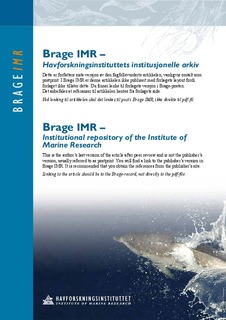| dc.contributor.author | Ndjaula, Hilkka O.N. | |
| dc.contributor.author | Nash, Richard D.M. | |
| dc.contributor.author | Slotte, Aril | |
| dc.contributor.author | Johannessen, Arne | |
| dc.contributor.author | Kjesbu, Olav Sigurd | |
| dc.date.accessioned | 2010-12-07T08:53:33Z | |
| dc.date.available | 2010-12-07T08:53:33Z | |
| dc.date.issued | 2010-05 | |
| dc.identifier.issn | 0165-7836 | |
| dc.identifier.uri | http://hdl.handle.net/11250/117131 | |
| dc.description | Journal homepage: http://www.sciencedirect.com/science/journal/01657836 | en_US |
| dc.description.abstract | The reproductive potential of Norwegian spring-spawning herring (Clupea harengus) was estimated in terms of total egg production (TEP) for the period 1935–2005, using a model where spawning stock numbers (SSN)-, weight- and length-at-age were combined with fecundity–weight relationships. In general, the modelled TEP was closely related to SSN. However, larger positive and negative deviations from this relationship were found in periods with high SSN in combination with increasing proportions of either recruit or repeat spawners and condition factor (K) below 0.73 or above 0.8. When relating the current estimated TEP to similar type of figures based on earlier data (including fecundity observations in 1951–1983), deviations were less pronounced, but they still tended to occur in periods of high SSN. These results suggest that at stable high stock levels, the population structure and its condition in terms of K, can have implications for the reproductive output. Hence, quantification of the reproductive potential as TEP has the potential to strengthen the stock–recruitment models, because it captures both the stock population structure and reproductive dynamics. | en_US |
| dc.language.iso | eng | en_US |
| dc.publisher | Elsevier | en_US |
| dc.subject | egg production | en_US |
| dc.subject | eggproduksjon | en_US |
| dc.subject | spawning | en_US |
| dc.subject | gyting | en_US |
| dc.subject | herring | en_US |
| dc.subject | sild | en_US |
| dc.subject | fecundity | en_US |
| dc.subject | fertilitet | en_US |
| dc.title | Long-term changes in the total egg production of Norwegian spring-spawning herring Clupea harengus (L.)—Implications of variations in population structure and condition factor | en_US |
| dc.type | Journal article | en_US |
| dc.type | Peer reviewed | en_US |
| dc.subject.nsi | VDP::Agriculture and fishery disciplines: 900::Agriculture disciplines: 910::Livestock breeding, rearing, reproduction: 912 | en_US |
| dc.subject.nsi | VDP::Agriculture and fishery disciplines: 900::Fisheries science: 920::Resource biology: 921 | en_US |
| dc.source.pagenumber | 19-26 | en_US |
| dc.source.volume | 104 | |
| dc.source.journal | Fisheries Research | |
| dc.source.issue | 1-3 | |
| dc.identifier.doi | http://dx.doi.org/10.1016/j.fishres.2010.04.002 | |
